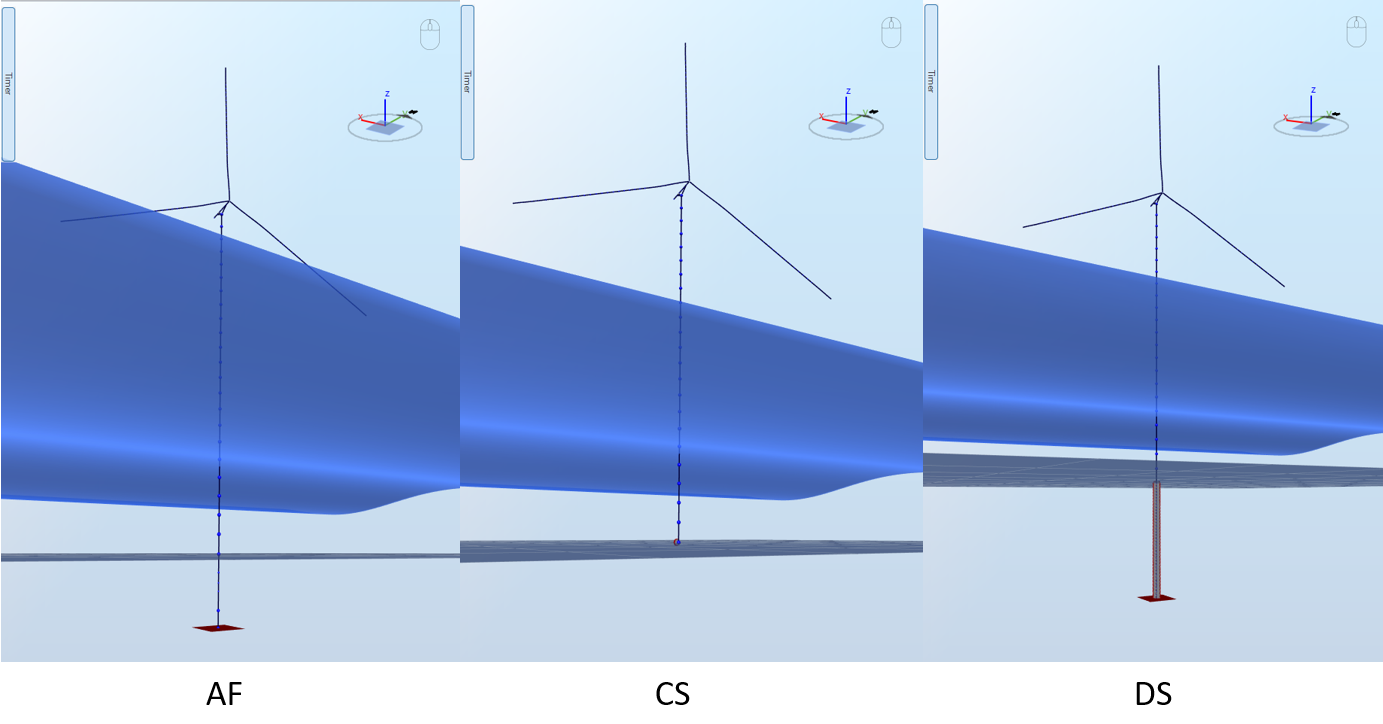OC3 Phase II
1 Test description
In Phase II, the NREL 5-MW wind turbine is mounted atop a monopile in 20 m water depth and three different types of soil-structure interaction that mimic the behaviour of a p-y model are analysed, namely:
- the Apparent fixity model (AF) in which the monopile is clamped below the seabed and its structural characteristics below the seabed are tuned so that its behaviour is similar to the p-y curve model
- the Coupled spring model (CS) where a 6x6 stiffness matrix is used to attach the monopile to the mean sea level
- the Distributed springs model (DS) in which linear springs are applied along the embedded length of the monopile
More details on these models can be found in
Jonkman et al. (2010k)
.
2 Model
This tests uses the
Offshore
template as the starting point.
The CSV file to run this test can be downloaded from
hre
.
The models used for this test are shown in the figure below:

3 Benchmarks
The results from the different participants as well as a detailed definition of the load cases and sensors can be found on
this link
.
Only Load case 4.1 is simulatied in this test. It is simulated for each of the three soilt-structure interaction models.
The sensors used for this benchmark are
-
the
Generator sensor
-
the
Rotor sensor
- a Beam element sensor at the mudline, 7 m below the mudline, half way from the mudline to the MSL, at the MSL and at the tower top, measuring the response loads in the elements
- a Beam element sensor at half the span of Blade 1
-
the
Blade [Time] sensor
- a Node sensor at the transition piece and the tower top, measuring the displacements of the nodes
- the Sea sensor , measuring the wave elevation
4 Results
Since this is a code to code comparison, there is by definition no correct result, the objective is to match as closely as possible the other participants of the project. However, the spread among participant is very wide and there are several outliers, which makes it hard to define the values that Ashes should be aiming for. Furthermore, it possible that although two sets of results are very similar, a phase difference in the tower shadow make them take very different values at a given instant.
For those reasons, there is no automatic fail/pass criteria on these benchmarks, only a visual inspection is performed. This report can be downloaded from the following link:
A regression test is also run on a daily basis to make sure that the results from Ashes always pass the visual inspection. This report can be downloaded from the following link;
5 Additional notes on the OC3 benchmark
- The transients from the results of the OC3 benchmarks have been removed, but we have not removed them in Ashes. It is thus expected that only the last 30 sec or so of the simulation should match the results from the other participants
- The results from the participants SWE _FLEX5 were removed from the benchmark as they were too different than the rest of the participants to fit in the same graph
- According to the OC3 specification document, the blades degrees of freedom should be deactivated. In Ashes, this is done by having an arbitrarily high stiffness. This implies that although displacements and deflections will be very small, they can be non-zero.
- It appears that no buoyancy loads were applied during this benchmark (because the axial force in the monopile is constant), we have therefore deactivated buoyancy loads in Ashes.
- There is a noticeable difference between Ashes and some other participants in the blade root torque for the cases where the rotor is not rotating. This seems to be due to differences in the position of the center of mass of the airfoils between the original definition of the NREL 5-MW blade (defined in Jonkman et al. (2009o) and which was presumably used in the OC3 benchmark) and the more recent BeamDyn definitions, which we have used to create our blade in Ashes (see NREL 5-MW ). Future work includes implementing the old blade to see whether we obtain a better match. However, it should be noted that the spread among participants is so wide that it is not trivial to decide what the Ashes results should look like to improve our match.